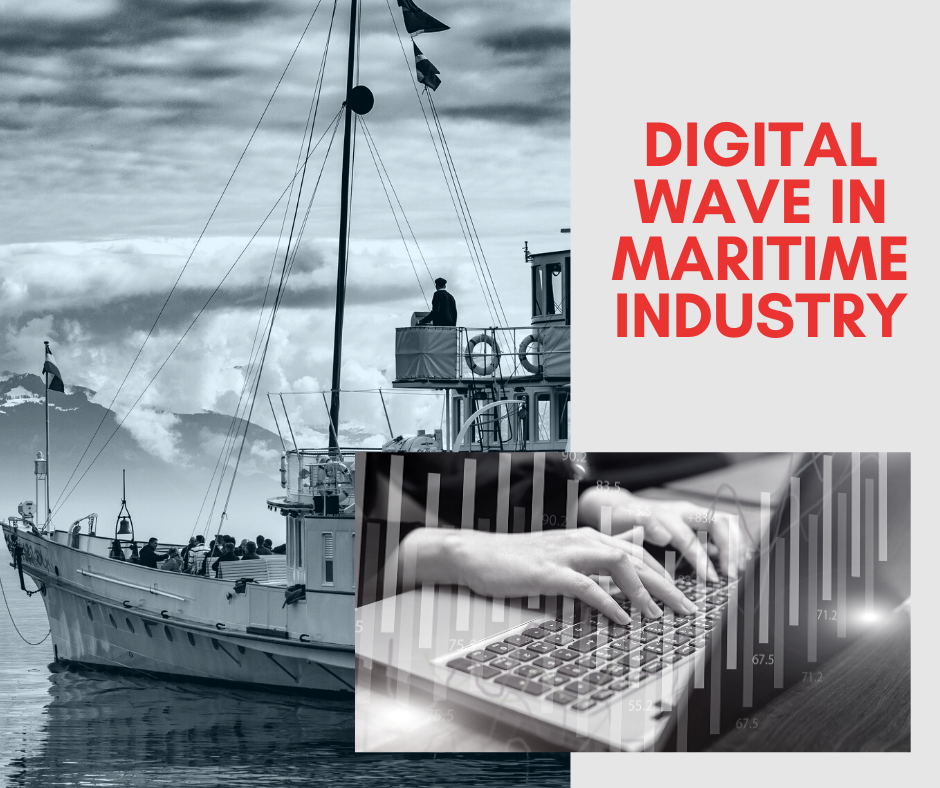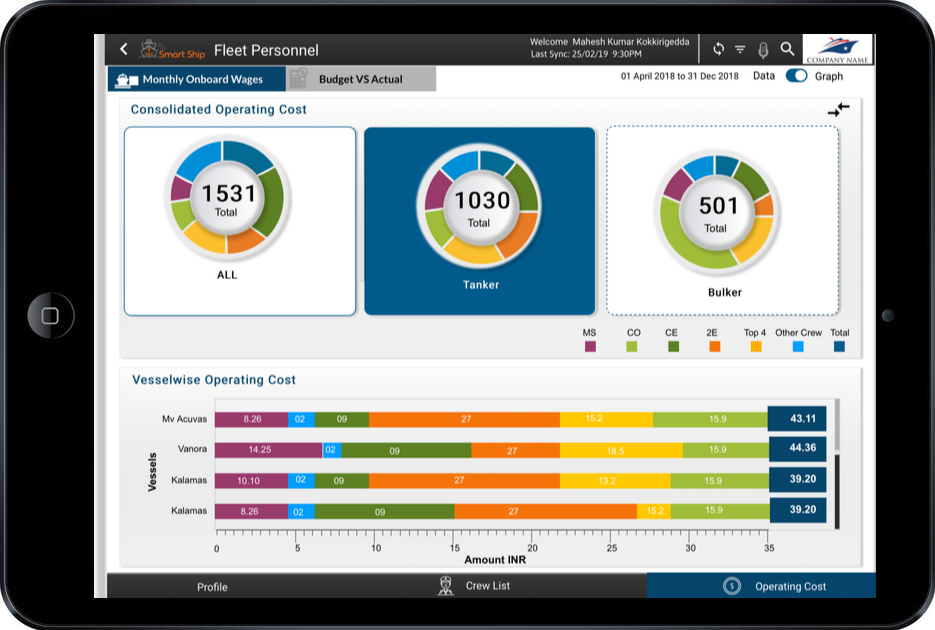
2017 saw a major shift in Maritime Technology , ranging from Smart Sensors synced with IOT ( Internet of Things) to automating entire shipping operations across vessel management to Dry Dock. “Industry 4.0 for Maritime Industry”, has enabled effective orchestration of multiple technologies that directly impacts maritime operations . Industry 4.0 in commercial Maritime industry has opened up a whole new vistas across:
- Human to Machine ( Interface devices, Mobile, PC)
- Machine to Machine ( Sensors, cloud, enterprise systems interacting in harmony)
- Machine to Human ( Visualization tools, Smart sensors, Hand held devices)
Maritime industry has come a long way compared to a decade back. The rate of technology innovation and adoption by Ship Owners and Ship Management companies will grow the fastest over next 5 years. Being the most preferred and cost effective mode of transport, maritime has become the critical part of every other industry and indeed the global economy. Despite being the most preferred mode of transport and being responsible for more than 90% of trade transport, maritime industry was the slowest to respond to the digital advancements.
Global Maritime industry has been going through tough times and most of it is attributed to archaic paper based office processes, heavy dependence on Manual interactions, unsynchronized processes, absence of meaningful data that drives decision, inadequate tracking, and higher waiting time for ships at the ports etc. were some of the reasons that ate away profits as many players stuck with their traditional way of doing things despite their inefficiencies. Some of the biggest examples being S.Korean shipping giants : Hanjin, Hyundai and many other prominent players from Singapore , Greece, US etc.
Digital Automation in Maritime Industry is bringing percentage savings to the tune of upto 15% which directly goes on to enhancing the bottom line of the organization. With growing competition and complex business processes, there is very little left for companies to get a competitive advantage that is offered by disruptive technology platforms. Ship owners and Ship management companies such as India’s largest Great Eastern Shipping Co. Ltd, and other prominent players such as PIL (Singapore), Maersk , P&O have taken up enterprise digitization as the only way to survive the competition and enhance their bottom line. Lets look at some very immediate impact that Digital Platforms are bringing in for Maritime companies especially in the domain of Bulkers, Tankers and Containers.
| Maritime Operations | Digital Automation Impact |
|---|---|
| Vessel Utilization | Enhancing vessel utilization through automated by upto 20%. Automated chartering process leading to |
| Dry Dock & Maintenance | Data analytics & trends bringing down Dry Dock costs in range of 10% to 22% , bringing in preventive maintenance routine, reducing downtime |
| Fuel | Efficient tracking & smart sensors keeping complete control on Fuel utilization and burn rate |
| Master & Fleet Management | Live business dashboard enables higher visibility on to Master Mariner and Fleet across all vessels , including daily cost mgmt |
| Voyage Economics | Live tracking of daily economics across all vessels |
| Port Procedures | Smart document management cutting time taken by upto 50% in port procedures and follow up documentation processes |
| Inspection & Check Lists | Automated mobile driven processes saving more than 40% of the time in routine and repeated processes |
| Business Margins | Block chain and cloud systems have in many places brought down broker/ agent margins , leading to higher bottom line for the ship management companies |
CLOUD | MOBILE | SMART SENSORS | IOT: working in perfect unison with the existing legacy systems .

SMART ALERTS , SMART CHARTS and VISUALIZATION ON MOBILE is enabling CXO’s and Maritime leaders take quick decisions on Chartering, signing upon a voyage or choosing the route that is most effective.
Cloud Platforms, Connected Technologies, Big Data and Analytics, Internet of Things (IoT), Artificial Intelligence are finding their implementations in the Maritime industry. Some of the successful use cases can be seen across select shipping companies who have been at the forefront of innovation.
Expensive Ship Management Software, Shipping ERP, Navigation Applications are being replaced by cheaper, robust and flexible cloud applications on mobile that makes complete economic sense. Tons of data generated by Vessel, fleet, Cargo, Brokers, Agents , Customers are now put in a pattern to extract meaningful information with help of Data Analytics and Artificial Intelligence. It is helping the companies to get rid of mundane and redundant tasks, improving overall efficiency and lowering the operational costs. And all these technologies are made available on handheld devices making it more convenient and user friendly, providing real time access to the required relevant data and information anytime and from anywhere.
Robots are being used to perform the primary as well as support functions which includes firefighting, ship inspection, crawling and cleaning of the hull etc. Shipping companies are already using hand held devices, iPad etc. for critical ship management processes including the Ship Inspection ( For technical as well as operational compliance) , using advanced sensors to detect any mishap and initiate the preventive action.
Mobile , iPad are the most effective visualization tool that maritime companies are increasingly using. However there is a word of caution for companies going in for digital automation. One of the best practices that has been yielding 100% results for various digital automation implementation includes undertaking the automation process in phases and systematically prioritizing the same. For ex: Planning, Operations management, commercials management and support functions management are some of the areas which must be given priorities in the beginning.
| Automation Phases | Expected Outcome |
|---|---|
| Phase I | Build consolidated business dashboard layer for the Sr. Management and departmental heads , on top of existing legacy system or existing ERP. Impact : Immediate information availability, quick decisions, data driven decisions instead of driving consensus. ** Effective Tracking and Control |
| Phase II | Build strong data architecture to capture minutest of the information across the organization pertaining to operations, voyage, customers, port etc. Impact: Data intelligence will enable deeper visibility in the business through trends, projections against historical reference point. ** Efficient business foresight |
| Phase III | Build Intelligent Enterprise through Smart Sensors, IOT platform and expandable cloud solution Impact: Cohesive digital ecosystem will bring down unnecessary cost leakages across Expensive and repetitive process, in efficient manual interactions and across all asset class. ** Complete digital ecosystem |
Unlike in the initial stage of the Maritime digitization, nowadays there are many technology vendors available who offer cost effective and customized solutions. But it must be considered that digitization doesn’t merely mean replacing one manual process with sophisticated software applications or autonomous robots, but also developing and nurturing digital friendly environment in the company, bringing in new talent or developing new skills in the old ones, implementing new ways to improve operations. Training and development of the crew must be given importance as they are the ones who will be the ultimate drivers and agents in the digital transformation process.
Technology change is faster than ever, and organizations now have a choice to reinvent themselves by being more responsive to the customer demands and dynamic market changes. Globally, maritime industry has been one of the late adopters of technology and unfortunately inefficient processes and traditional work methods have started showing its signs of negative impact.
It is time for global shipping fraternity to embrace the possibilities that technology has brought in. The only way to turn around the sector is by consciously bringing in automation across existing processes and connecting all the dots that was left behind all this while.